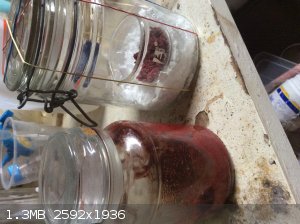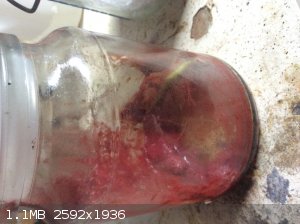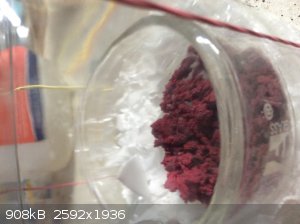j_sum1
Administrator
       
Posts: 6231
Registered: 4-10-2014
Location: Unmoved
Member Is Offline
Mood: Organised
|
|
The chromium trioxide saga
Periodically on these boards I have posted questions about chromium trioxide. The school I work at has a container labelled CrO3 that is at least 20
years old: probably 30. Opening the container reveals a black sticky tar-like substance. Evidently the compound has absorbed some moisture
(unsurprising), but there is always the possibility of contaminants.
That began a bit of a learning sequence for me – what uses does CrO3 have? How to handle it safely? What can be done to resurrect this vile gunk?
In the process I have acquired my own CrO3 and have experimented with that.
So. This post is a bit of a summary of what I have discovered about this container of gunk and an appeal for some suggestions.
Some initial observations:
Colour is black/brown. Nothing much I did produced the bright reds and oranges that Cr(IV) is known for.
Reasonably difficult to dissolve in water. Really sticky and tacky paste and difficult to stir. Sticks to everything. Eventually does dissolve.
Difficult to dissolve in concentrated sulfuric acid. Similar problem.
Dehydration unsuccessful. I managed to get a thicker tar but nothing that resembled normal CrO3.
Reactions:
It obviously contains Cr(IV). Reduction gives the deep green compounds characteristic of Cr(III)
Mixed with H2SO4, I attempted to use it as a test for Cl- ions. (Chromyl chloride test). Discoloration occurred, but not the bright red oily
substance expected. Instead a dirty brown/purple appeared.
I mixed with a stoichiometric quantity of NaOH – attempting to make some sodium dichromate. Again, no reddish orange colours. Instead there was a
dirty brown precipitate and deep brown liquid. This was left for several weeks. pH was neutral. I assumed at first a stoichiometric fluke but I now
doubt it.
Attempts to isolate a Cr compound from the mess:
I filtered some of this liquid and boiled it down. The solution turned greenish. A grey-green precipitate that looked like Cr2O3 appeared. I was
more than a little surprised to have it reduce simply by heating. The precipitate was not uniform however. Some darker brown material was also
present.
Thinking that there was probably some Cr(IV) present, I decided to reduce it deliberately. I added some ethanol and HCl. The precipitate redissolved
in the acidic conditions. The result was a clear solution of a deep forest green colour. It also had an unusual smell – some aldehydes and
something else.
I then boiled down again to hopefully drive off the organics. The solution became cloudy on heating. The smell also became a lot stronger.
After reduction by about 50% I filtered again. The filter cake was a bright green colour (chromium hydroxide?)
Then the big surprise: Small 2-3mm nuggets of sulfur were found in the bottom of the beaker. The only place the sulfur could have come from was the
original material.
Time was running short and so I bottled up the remaining liquid to continue with it at home. At this point I reasoned that the bulk of what I had was
chromium chloride.
Further reduction in the home lab – attempting to isolate CrCl3 – a lot of sulphurous smells produced. I think probably SO2.
A light coloured precipitate began to appear. I let the mixture cool.
I now have a light coloured precipitate in a beaker containing 80mL of deep green solution. Hard to tell the colour – I have not filtered it out
yet. It does not seem to be sulfur. Remaining solution has a pH of 1.
My guesses:
I think that the chromium trioxide, as well as having some absorbed water, has also had a significant quantity of elemental sulfur added. Maybe as
much as 50%.
The tarry material was the result of some kind of polymerisation. That explains why it was so difficult to handle. I don’t know that the
solubility of the material was adequately explained.
The precipitates obtained along the way were a combination of oxides, hydroxides and sulfates. Since I was not expecting sulfur to be present at all,
I really don’t know. I was not controlling or recording variables enough to be confident of anything.
My remaining precipitate is probably sodium sulfate. There should still be NaCl dissolved in the solution as well as probably chromium chloride.
Questions:
Is my guess reasonable or is it just a stab I the dark?
What would happen if CrO3 was mixed with sulfur? I should probably just go ahead and try it.
Why would someone add S to CrO3? (And leave it in the original container!!) This seems bizarre. Is there any practical reason?
Suggestions for a way to confirm my guess? (Maybe it was a different sulfur-containing compound added.)
Suggestions for what to do with this mess. There is still 350g left. A confirming analysis and simple disposal method would be good if there is
nothing practical that can be done.
[Edited on 10-12-2015 by j_sum1]
|
|
|
Tdep
National Hazard
   
Posts: 516
Registered: 31-1-2013
Location: Laser broken since Feb 2020 lol
Member Is Offline
Mood: PhD is done! It isn't good but it's over lol
|
|
Inspired by your initial posts on CrO3 I made up some from Conc. Sulfuric and potassium dichromate. This results in a sticky red mass that I placed
into a dessicator over CaCl2 for the past however many months. I must say the chromium trioxide has done a spectacular job of further drying the
calcium chloride and now looks slightly more stickier than when I put it in. I might try potassium hydroxide to see if that is an improvement over the
CaCl2.
I will have to build or buy a vaccuum dessicator ive decided, if I want it dry to the point it ignites ethanol. But as someone pointed out in a
different thread, vaccuum and ghetto should not be used next to each other often, so im taking my time.
Always following any CrO3 adventures you make j_sum1!
|
|
|
User123
Harmless

Posts: 40
Registered: 31-10-2015
Member Is Offline
Mood: No Mood
|
|
Use small beakers of sodium hydroxide and sulfuric acid for desiccant. As far as I know that is one of the most aggressive desiccants that one can
make. If that doesn't do it, then perhaps resort to vacuum drying.
Let us know how you get on, as I'm interested in doing it too.
|
|
|
Tdep
National Hazard
   
Posts: 516
Registered: 31-1-2013
Location: Laser broken since Feb 2020 lol
Member Is Offline
Mood: PhD is done! It isn't good but it's over lol
|
|
Fighting sulfuric with sulfuric? Ok, ill try that. Actually, ive got the KOH to spare more, ill try KOH first. I also have some NaClO4 which appears
to be the most hygroscopic thing I own, does that make it a good dessicant?
|
|
|
User123
Harmless

Posts: 40
Registered: 31-10-2015
Member Is Offline
Mood: No Mood
|
|
I've never heard of it as a desiccant, but it can't hurt to add it. I've always used the combination I suggested. It's good for drying organics as the
presence of acid and base sucks up any volatile solvents such as AcOH and NEt3.
KOH should be much better than CaCl2 too.
[Edited on 10-12-2015 by User123]
|
|
|
Tdep
National Hazard
   
Posts: 516
Registered: 31-1-2013
Location: Laser broken since Feb 2020 lol
Member Is Offline
Mood: PhD is done! It isn't good but it's over lol
|
|
I decided to move my chromium trioxide into a new despicable today and was pleasantly surprised. While it was mostly sludgy still, there was a mass of
crystals in there that seemed to have separated and somewhat dried out! I took that mass out (it was solid enough to move together as one piece) and
vacuum filtered off more liquid (my vacuum is much better now than it was). I've moved it to a new dessicator above KOH. I forgot to weigh the
watchglass but it's turned humid so I'll do that another day.
Picture are the container that was surrounded by the CaCl2 with residual red sludge as well as the new dessicator with the pretty red crystals.
It's not dry enough to ignite ethanol yet but I feel progress has been made.
  
|
|
|
ave369
Eastern European Lady of Mad Science
   
Posts: 596
Registered: 8-7-2015
Location: No Location
Member Is Offline
Mood: No Mood
|
|
I, too, do have some red crystals in a jar marked as CrO3. They most resemble the substance from Tdep's third photo. They are deep red without a hint
of black.
Made it by pouring the strongest H2SO4 I had (96%) on potassium dichromate crystals, vigorous mixing and filtering through sintered glass. In the
Shott funnel it looked like deep red goop.
There was no water in the reaction, except for the 4% in the sulfuric, with which it does not part easily. I sucked the H2SO4 thoroughly through
vacuum and collected the deep red mass from the Schott funnel.
[Edited on 15-12-2015 by ave369]
Smells like ammonia....
|
|
|
woelen
Super Administrator
        
Posts: 7977
Registered: 20-8-2005
Location: Netherlands
Member Is Offline
Mood: interested
|
|
How do you get rid of the last adhering H2SO4? Making nice dry CrO3 in this way to my opinion is impossible, unless you can find a volatile solvent,
which dissolves the adhering H2SO4 while not dissolving the CrO3. I do not know of such a solvent.
|
|
|
ave369
Eastern European Lady of Mad Science
   
Posts: 596
Registered: 8-7-2015
Location: No Location
Member Is Offline
Mood: No Mood
|
|
So probably the deep blackless red of our CrO3 comes from sulfuric acid contamination. I thought so, too.
Smells like ammonia....
|
|
|
woelen
Super Administrator
        
Posts: 7977
Registered: 20-8-2005
Location: Netherlands
Member Is Offline
Mood: interested
|
|
I have a sample of pure CrO3 and it is dry and non-sticky. It consists of scales, which are flee flowing. The color of these scales is very dark
red/brown. Solutions of this material are brown/black at very high concentration. On dilution these solutions are orange, like dichromate solutions.
|
|
|
DJF90
International Hazard
    
Posts: 2266
Registered: 15-12-2007
Location: At the bench
Member Is Offline
Mood: No Mood
|
|
I'm surprised no-one makes use of the forum library. There you shall find "Synthetic Inorganic Chemistry" by Blanchard, and on pp. 324-325 there is a
preparation of CrO3 from sodium dichromate and conc. sulfuric acid. It also addresses the issue of residual sulfuric acid, and deals with this problem
nicely by washing with nitric acid (volatile). A copy of the required pages can be found attached in .pdf format.
Attachment: CrO3.pdf (200kB)
This file has been downloaded 319 times
[Edited on 15-12-2015 by DJF90]
|
|
|
ave369
Eastern European Lady of Mad Science
   
Posts: 596
Registered: 8-7-2015
Location: No Location
Member Is Offline
Mood: No Mood
|
|
I'll try the washing with nitric in a Schott funnel route when my new Wurtz flask arrives. My Buchner flask is way too big for my Schott funnel, and
the Wurtz is all right, so I'll give it a try.
Upd: also WOW! A solvent about which woelen the Illustrious did not know! That's a hoot! Thanks DJF90!
[Edited on 16-12-2015 by ave369]
Smells like ammonia....
|
|
|